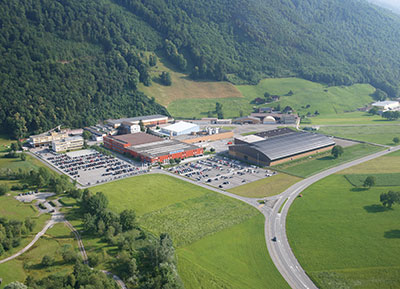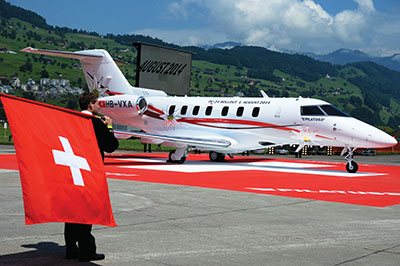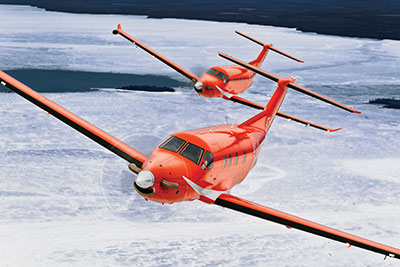
Features
Aircraft
Celebrating a new class
When someone invokes the word “Swiss,” it immediately conjures up certain stereotypical images: the beauty of the Alps, military neutrality, secret bank accounts, gourmet chocolate, or precision watches.
September 8, 2014 By Rick Adams
When someone invokes the word “Swiss,” it immediately conjures up certain stereotypical images: the beauty of the Alps, military neutrality, secret bank accounts, gourmet chocolate, or precision watches.
 |
|
| Photo: Pilatus
|
But to better define the Pilatus Aircraft company, it helps to be aware that their headquarters in Stans, near Lucerne, is in the German-speaking section of Switzerland, not la langue française or rumantsch enclaves to the west and south.
The Swiss-German identity thus adds an extra layer of disciplined thinking to the Pilatus mindset, much like the fused fibres of a composite component, a finer tuning of precision and pride in craftsmanship that comes through in the performance of Pilatus aircraft, as well as consistent accolades for customer support.
“We have learned to preserve good Swiss values such as dependability, honesty, and a sense of responsibility whilst yet accepting other ways of thinking,” said Oscar J. Schwenk, Pilatus Chairman.
Pilatus is not-so-secretly pleased when observers refer to its aircraft as “over-engineered.” If you spend as much time understanding the customers as they do, you’d appreciate the harsh environments – weather extremes, altitudes, dust, stones, birds – that lead them to explore durable designs, simplified parts molded from a single chunk of metal, laser-precise machining tolerances, anti-corrosion coatings, and innovative sealant techniques which add both safety and longevity.
The company is almost religious about efficiency. Retaining most component design and production in-house, they use a highly automated parts process in which machines retrieve the tooling and raw materials, then create the part . . . and finally compact the metal shavings to save on transport to the recycler. For just one part, the Flexibles Fertigungs System (Flexible Manufacturing System) reduced setup time from 630 minutes to a mere 9 minutes and production time was cut from 249 to 80 minutes.
Pilatus is also constructing a new logistics building which will almost completely automate the entire internal supply chain process, especially the storage and “picking” process. One of their dilemmas is having to import almost all raw materials, as Switzerland lacks suppliers of aviation-grade aluminum and other critical elements.
Overwhelming response to the PC-24
I visited Pilatus headquarters a few days after the company’s August 1 “Swiss National Day” celebration – which encompassed both the company’s 75th anniversary and the rollout of the prototype PC-24, the first business jet to be built in Switzerland.

|
|
| Some 25,000 people descended on the Swiss town of Stans August 1 for Swiss National Day celebrations, the company’s 75th anniversary, and the rollout of the new PC-24. Photo: Pilatus |
By the way, the beauty of the Alps is even more incredible than the stereotype, enhanced by the sun and shadows playing on the Vierwaldstättersee, or Lake Lucerne, which you quickly overfly only a few hundred metres from the end of the Buochs airstrip adjacent to the Pilatus complex. The local chocolate is quite satisfying too. But, as for bank secrecy, that’s pretty much a footnote in history now.
The euphoria of having 25,000 people show up in tiny Stans, permanent population barely above 8,000, was still lingering in the machine shops, the employee canteen, and the final assembly hall when I toured.
The new PC-24 represents a huge investment for the company. My host, Markus Kälin, Executive Assistant to Schwenk, told me Pilatus will spend about 400 million Swiss francs (CHF) – $485 million Canadian – on the PC-24 development, another 100 million CHF on new buildings, and yet another 100 million CHF on new machinery. But the privately held company will not rely on banks for financing; they have been debt-free the past 11 years. “Our stable Swiss shareholder base,” explained Schwenk, “remains a guarantee that we do not become an object of speculation or end up with a competitor as a result of an unfriendly takeover.”
This is not the first time Pilatus has invested heavily in a new aircraft on which the relatively small (1,800 employees) company’s future depended. Two decades ago, while part of Oerlikon-Bührle, which Schwenk said, “was being driven into a sell-out by incompetent management” at the time, Pilatus sought a second source of revenue to supplement the fickle military market into which they were selling PC-7 and PC-9 trainer aircraft. “Everyone rushed to bury the PC-12 before it even got off the ground,” he recalled. But Pilatus prevailed and has sold more than 1,300 PC-12s, including the current PC-12NG variant.
There should be little consternation about the success of the PC-24. Pilatus announced at the European Business Aviation Conference and Exposition (EBACE) in Geneva, Switzerland in May that they had sold 84 PC-24s and therefore closed the new order book for the time being. Announced buyers are the Royal Flying Doctor Service of Australia, which was also the launch customer for the PC-12; United Arab Emirates-based charter Falcon Aviation Services; U.S. (New Hampshire) fractional PlaneSense, which operates 30 PC-12s; Luxembourg shared ownership operator Jetfly; U-Haul International; and the Swiss Air Force.
The 84 orders cover PC-24 production ramp-up from initial deliveries in 2017 through 2019. The maiden flight, originally announced for late this year, is now targeted for early 2015. Three prototype aircraft will be produced for 2,300 hours of flight testing, carried out in Switzerland, and also in U.S. airspace together with Advanced Cockpit Environment (ACE) avionics supplier Honeywell and Williams International, selected for its FJ44-4A 3,400-lb. takeoff thrust powerplant. (The engines, by the way, will include an automatic thrust reserve to 3,600 lb., very helpful for single-engine climb-out in case of an engine failure, as well as a “quiet power mode” or auxiliary power unit idle mode, which is critical for Canadian operators who fly into remote locations which lack infrastructure.)
Pilatus has about 300 engineers working on the PC-24 and other technical developments. Their workforce also features 100 young apprentices who are learning everything from polymechanics to composites to design for customer paint schemes through a four-year work-study program. Schwenk said such apprentices “hold the future of the Swiss economy in their hands. It is my personal belief that the Swiss system of dual vocational training is one of the best in the world, and we must take care of it.”
Mountain heritage
Pilatus Aircraft takes its name from Mount Pilatus, which is actually multiple peaks due west of Stans, the highest being Tomlishorn at 2,128 metres (6,982 feet), from which you can see 73 other mountaintops, including Mont Blanc well to the southwest. One legend claims the notorious Pontius Pilate was buried there, but Monte Vettore in central Italy makes the same incongruous boast. Another tale, from medieval times, says a winged dragon lived on the mountain – the carved-out cave viewing tunnel is called the Dragon Walk. Today, there are modern fire-breathers; gun emplacements just below the tourist area reportedly continue to protect Swiss neutrality.
The Pilatus campus is actually located hard against another famous mountain, the Bürgenstock, among the most visited tourist destinations in Switzerland, once home to actors Audrey Hepburn and Sophia Loren, Charlie Chaplin and Yul Brynner.
The aircraft company location was chosen in 1939 in part because of the Buochs military airfield and in part because Swiss officials envisioned digging tunnels into the mountain to protect aircraft in production from enemy bombardment. Tunneling into the nummulitic limestone was ultimately determined to be too expensive, and fortunately there never were any air raids
It’s certainly a rugged location, one that, like the aircraft it manufacturers, aptly typifies its strength, durability and longevity in the market.
The Canadian connection
Two words, which pop up frequently in conversations about the Pilatus PC-12 single-engine turboprop aircraft, are “rugged” and “remote,” and Canada has plenty of terrain which can be described by either or both adjectives.
 |
|
| The Pilatus PC-12 is the aircraft of choice for a number of Canadian operators, including Ornge, Ontario's air transport provider. Photo: Pilatus
|
“It’s an aircraft that has no problem operating in minus 40 degree conditions,” Stan Kuliavas told Wings. Kuliavas is Vice President, Sales and Business Development for Pilatus Centre Canada. “One of the first things you notice about the PC-12 is how overbuilt it is and how high it sits off the runway. Flying pavement to pavement, the aircraft gets babied, quite honestly. It’s really beefy trailing link landing gear allows for smooth landings in remote, unimproved surfaces – everything from dirt, snow, gravel, ice, grass.”
“In Canada,” Kuliavas noted, “we have a lot of remote landing areas, or in the case of mining companies where they’re excavating up north, there are no runways. It’s actually just a dirt road they shut down to allow an aircraft to land. Once the aircraft taxis away, it becomes a road again. Those are environments the PC-12 is very comfortable operating in.”
Since 1997, Pilatus Centre Canada, headquartered in Thunder Bay, Ont. with presence across Canada, has been the exclusive sales and service dealer for Pilatus aircraft in Canada, which basically coincides with the introduction of the PC-12. They now also sell the new PC-24 business jet, which offers many of the same capabilities as the PC-12 for accessing short and unimproved runways but does so with greater speed. President and CEO Robert Arnone and Steve Davey, COO and Director of Maintenance lead the company.
The Swiss-made PC-12 is quite popular in Canada, currently representing about seven to eight per cent of the more than 1,300 aircraft fleet sold worldwide. For a country of 35 million people, or about half of one per cent of the world’s people, “to have almost 10 per cent of the global fleet of an aircraft is an indication of how well that aircraft fits into the Canadian geography in the mindset of an operator here. Everything from its performance characteristics to its operating economics make it a great airplane for Canada,” Kuliavas said.
Among the PC-12 operators in Canada: Pascan Aviation, which claims to be the largest independent airline in Quebec, serving 17 destinations in the eastern part of the country; First Nations-owned Wasaya Airways, which provides charter services and cargo supply of food, clothing, medicines, and other essentials to remote communities in Ontario; Ontario’s Ornge air ambulance service; the Royal Canadian Mounted Police; the Ontario Provincial Police; and the Nishnawbe-Aski Police Service, whose First Nations jurisdiction encompasses two-thirds of Ontario (about 15 times the size of Switzerland).
Because it can access so many more airports than most aircraft and its renowned reliability, some of the highest-time PC-12s in the world operate in Canada. “We have a great mix of aircraft used for executive transport, the owner-operator segment, aeromedical, and commercial lift where they’re often used as part of an airline fleet n the north," Kuliavus said. “It's a great airplane for that because it’s not the 10,000-foot paved runways of southern Ontario; you’re flying into dirt roads or iced-over gravel runways that not every aircraft can get into. The PC-12 works very well in those environments.”
Kuliavas said the dispatch reliability of the aircraft contributes in direct correlation to the amount of hours flown. “When you want to go, it goes. For a commercial operator, that’s quintessential to their
survival as a company.”
Pilatus Centre Canada often encounters milestones with the PC-12 sooner than other parts of the world. “That has led to a really strong knowledge base about the aircraft that we openly share with other dealers and service centres and with the Pilatus factory in order to make the Pilatus owner and operator experience as good as possible,” Kuliavas stated.
In fact, Canadian high-time operators triggered a life extension program (LEP). The original certified life of the PC-12 was 20,000 hours. But when some Canadian operators were approaching that limit, “They said, basically, ‘We’re not parking this airplane. It’s still a great machine. We need to figure out a way to keep this thing flying,’ ” Kuliavas said. Together with the Pilatus factory in Switzerland, PCC devised a program, “that guts the entire aircraft, checks every component and system, replaces anything that needs replacing, and you essentially bring it back to almost new status.” The LEP result is an extension to 50,000 hours, a 150 per cent increase over the original life limit.
“To a commercial operator who is a high-time, high-utilization customer, this is very attractive. Pilatus Centre Canada and the factory in Switzerland are the only places in the world authorized to do this life extension.”